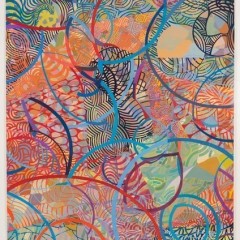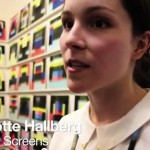
Oil Rugs in Themescapes, an installation by Paul Coors, Jamie Dillon and Nick Paparone
Romantic notions of the American landscape, American optimism, suburbia and relentless home decoration meet in a sometimes hilarious installation by Paul Coors, Jamie Dillon and Nick Paparone at 222 Gallery in Old City.
The installation, Themescapes, includes wallpaper that looks like siding, fabric that looks like bricks and cardboard fashioned into faux wood house framing. But where the work takes off is where it no longer looks quite like anything it’s imitating.
The oil rugs, which suggest a fabulous griminess, are shaped like puddles with subtle oily rainbows applied on the black surface. Sited as they are in front of a real garage entry, they raise issues of what is worthy of our notice and our reproduction of it into a work of art. They also bring to mind Paparone’s own Faux Show “Raccoon Rug,” made with many of the same thoughts.
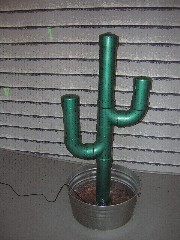
the cactus fountain in front of the siding wallpaper, paint drips and all
I was crazy about the cactus fountain. Made of PVC pipes, painted (auto paint?) a shimmery green, the cactus dribbles water out of its top hole. The whole notion of a cactus as a fountain is so wrong-headed it’s priceless. Situated in a galvanized tin bucket pond with pennies lining the bottom, it is a sort of DIY zen water feature.
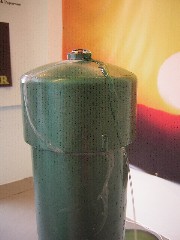
detail of the dribbling cactus fountain
Behind it is a wall of screenprinted-on-wallpaper aluminum siding, and beyond it is a wall-sized image of some California dreaming, a stereotypical setting-sun photo. The concrete floor, which is the real floor of the gallery, also works as a concrete entryway, making the fountain a hope-laden attempt to transform a concrete patio into a garden. I love paving nature and then evoking it according to our fantasies, which is certainly something we do. Too funny.
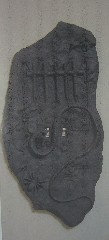
the decorative light-switch plate
My other favorite piece in this installation is the out-of-control light-switch plate. That anyone should care so much about a switch plate has always puzzled me, just like people go crazy about the knobs on their kitchen cabinets. So this homely-looking, clay gray monstrosity decorated with a snake, a bug, a fence and other outdoor phenomena in the den/livingroom or whatever that room, with the grow-light sofa, tickled me.
I was also charmed by the boyish choices. This switch plate bears little resemblance to the flowery decorative ones at the hardware store or the color-laden ones sold at crafts sales. It’s a cooked up thing that talks to the notion of a male space, a den fantasy.
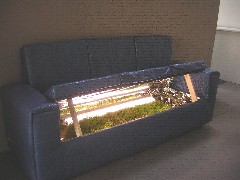
the grow-light sofa
Of the grow-light sofa, all I could think was it may be a lawn growing under the cushions but really, shouldn’t this have been a little marijuana farm? Well, we don’t want our artists arrested for something like this, and the lawn indoors with the concrete outdoors seemed pretty funny to me. We’ve all been at the tanning salon too long, trying to look naturally outdoorsy, and we’ve done the same thing to our skin that we used to do to just our homes.
I also had to laugh at the resemblance of the sofa to Nari Ward’s Glory, the coffin tanning bed at the Whitney Biennial.
I also liked lighting up what grows under the cushions in all our sofas.
Other features of the installation worth noting include poster exhortations to live right and think positively–silkscreened takes on sampler homilies–and a painting of a Do-It-Yourself-er’s peg board.
All that misguided optimism and home improvement gets a good poke in the ribs in Themescapes.
By the way, Paparone and artist Tim Gough, formerly a Space 1026-er, have started a business Art in the Age of Mechanical Reproduction, with a little help from Gyro running the company. It sells screen-printed t-shirts and such designed by artists (Coors and Dillon are among the participating artists).
For my Flick set of photos of the installation, go here.


